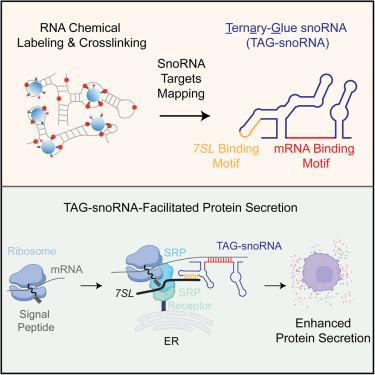snoRNA-facilitated protein secretion revealed by transcriptome-wide snoRNA target identification
IF 45.5
1区 生物学
Q1 BIOCHEMISTRY & MOLECULAR BIOLOGY
引用次数: 0
Abstract
Small nucleolar RNAs (snoRNAs) are non-coding RNAs known for guiding RNA modifications, including 2′-O-methylation (Nm) and pseudouridine (Ψ). While snoRNAs may also interact with other RNAs, such as mRNA, the full repertoire of RNAs targeted by snoRNA remains elusive due to the lack of effective technologies that identify snoRNA targets transcriptome wide. Here, we develop a chemical crosslinking-based approach that comprehensively detects cellular RNA targets of snoRNAs, yielding thousands of previously unrecognized snoRNA-mRNA interactions in human cells and mouse brain tissues. Many interactions occur outside of snoRNA-guided RNA modification sites, hinting at non-canonical functions beyond RNA modification. We find that one of these snoRNAs, SNORA73, targets mRNAs that encode secretory proteins and membrane proteins. SNORA73 also interacts with 7SL RNA, part of the signal recognition particle (SRP) required for protein secretion. The mRNA-SNORA73-7SL RNA interactions enhance the association of the SNORA73-target mRNAs with SRP, thereby facilitating the secretion of encoded proteins.

通过转录组范围内的 snoRNA 目标鉴定揭示 snoRNA 促进蛋白质分泌的作用
小核RNA(snoRNA)是一种非编码RNA,已知可引导RNA修饰,包括2′-O-甲基化(Nm)和假尿苷(Ψ)。虽然 snoRNA 也可能与其他 RNA(如 mRNA)相互作用,但由于缺乏有效的技术在转录组范围内识别 snoRNA 的靶标,人们仍然无法了解 snoRNA 靶标的全部 RNA。在这里,我们开发了一种基于化学交联的方法,全面检测 snoRNA 的细胞 RNA 靶标,在人体细胞和小鼠脑组织中发现了数千种以前未被识别的 snoRNA-mRNA 相互作用。许多相互作用发生在 snoRNA 引导的 RNA 修饰位点之外,暗示着 RNA 修饰之外的非规范功能。我们发现,这些 snoRNA 中的 SNORA73 以编码分泌蛋白和膜蛋白的 mRNA 为靶标。SNORA73 还与 7SL RNA 相互作用,后者是蛋白质分泌所需的信号识别颗粒(SRP)的一部分。mRNA-SNORA73-7SL RNA 的相互作用增强了 SNORA73 目标 mRNA 与 SRP 的结合,从而促进了编码蛋白质的分泌。
本文章由计算机程序翻译,如有差异,请以英文原文为准。
求助全文
约1分钟内获得全文
求助全文
来源期刊

Cell
生物-生化与分子生物学
CiteScore
110.00
自引率
0.80%
发文量
396
审稿时长
2 months
期刊介绍:
Cells is an international, peer-reviewed, open access journal that focuses on cell biology, molecular biology, and biophysics. It is affiliated with several societies, including the Spanish Society for Biochemistry and Molecular Biology (SEBBM), Nordic Autophagy Society (NAS), Spanish Society of Hematology and Hemotherapy (SEHH), and Society for Regenerative Medicine (Russian Federation) (RPO).
The journal publishes research findings of significant importance in various areas of experimental biology, such as cell biology, molecular biology, neuroscience, immunology, virology, microbiology, cancer, human genetics, systems biology, signaling, and disease mechanisms and therapeutics. The primary criterion for considering papers is whether the results contribute to significant conceptual advances or raise thought-provoking questions and hypotheses related to interesting and important biological inquiries.
In addition to primary research articles presented in four formats, Cells also features review and opinion articles in its "leading edge" section, discussing recent research advancements and topics of interest to its wide readership.
 求助内容:
求助内容: 应助结果提醒方式:
应助结果提醒方式:


